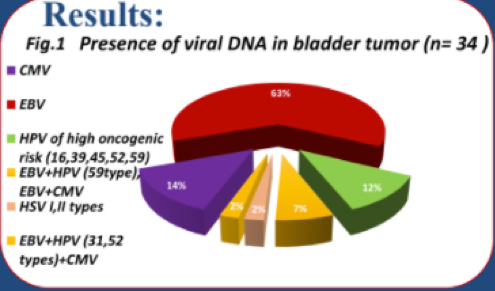To that effect, they completed a survey 100 patients treated with bladder cancer (72 men and 28 women) aged 38 to 90 years (mean age 65±10). In addition to routine testing, blood tests for IgG and IgM to HSV type I and II, CMV, EBV were taken. On the other end, PCR of the tumor itself to look for HSV type I and II, CMV, EBV, HPV of high oncogenic risk was completed. In the 34 patients with positive presence of viral DNA, immunohistochemical study with the detection of expression of Ki67, CD31, p53, Bcl-2, CD44 and EFGR, PDL-1 was performed.
Of the 100 patients, 27 patients had EBV DNA detected, 6 had CMV DNA, 5 had HPV high-risk types (16, 39, 45, 52, 59), and 1 patient had HSV I + II. From these 34 patients, four patients actually were identified with more than one virus (HPV+EBV in one case, EBV+СMV in 2 cases, CMV+EBV+HPV in one case).

When looking at IHC correlation, the presence of EBV DNA correlated with the expression of CD31 (R=0.325) and Ki67 (R=0.334); HPV of high oncogenic risk with Bcl-2 (R= 0,524, p=0,045). The presence of koilocytes and intranuclear inclusions as signs of HPV infection correlated with the expression of CD31 (R=0.518, p=0.007), CD 44 (R=0.334) and EGFR (R=0.315), CD 31 (R=0.537, p=0.007), CD44 (R=0.55), Ki67(R=0.375) respectively. High level of anti-EBV IgG-EBNA correlated with the expression of EGFR (R=0.35, p=0.08), Ki 67 (R=0.425), CD44 (R=0.42). The level of anti-EBV IgG-VCA correlated with the expression of EGFR (R=0.405, P=0,04), Ki67 (R=0.49), CD44 (R=0.635, p=0.09). However, while the authors note all these correlations, many of the R-values are not impressive and most of them are not significant (p>0.05)!
In the one patient aged 50 who had DNA of three viruses in the tumor tissue, non-muscle-invasive bladder cancer showed 99% expression of PD-L1 in tumor cells.
The authors note that latent viral infection probably increases proliferative and metastatic activity of the bladder tumor and reduction of apoptosis, which probably leads to progression and recurrence of bladder cancer. However, as noted before, not all the data reported was statistically significant – hence this is all still theoretical. No strong conclusions can be made at this time.
Presented by: I. Kosova, Moscow City Hospital named by V.P Demikhov, Dept. of Urology, Moscow, Russia
Co-Authors: Loran O. 2 , Sinyakova L. 2 , Gundorova L. 3 , Kosov V. 4 , Kolbasov D. 5, Pogodina I. 6
Author Information:
2. Russian Medical Academy of Postgraduated Сontinuous Education, Dept. of Urology, Moscow, Russia
3. Moscow City Hospital named by V.P Demikhov, Dept. of Pathology, Moscow, Russia
4. Komi Republican Oncologic Hospital, Dept. of Urology, Syktyvkar, Russia
5. Moscow City Hospital named by V.P Demikhov, Dept. of Urology, Moscow, Russia
6. The Vologda Regional Clinical Hospital № 2, Dept. of Pathology, Cherepovec, Russia
Written by: Thenappan Chandrasekar, MD Clinical Fellow, University of Toronto, twitter: @tchandra_uromd at the 2018 European Association of Urology Meeting EAU18, 16-20 March, 2018 Copenhagen, Denmark


